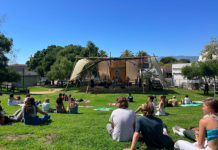Alyssa Tinoco
Contributing Writer
On Tuesday, Feb. 4, the Carsey-Wolf Center welcomed Kira Snyder, an award-winning writer and executive producer, for a screening of episode 11 from season two of the hit TV show “The Handmaid’s Tale” (2017-present). After the screening, Snyder and Emily Zinn, the associate director of the Carsey-Wolf Center, took the stage for a recorded post-screening discussion of the episode and the series.
During the discussion, writer Snyder talked about the ways in which Bruce Miller, the showrunner, adapted Margaret Atwood’s novel. Originally a 1985 best-selling novel, “The Handmaid’s Tale” explores a “what if” scenario based around a realistic dystopian society faced with a failing birthrate and a deteriorating environment.
Miller and his TV crew decided to add their own creative interpretation of the society to the one Atwood created in her novel. With their own take on Atwood’s speculative fictitious world, the crew utilized its features and adjusted its content, which allowed for them to stretch the story’s plot with further development in backstories and subplots.
The writer mentioned she has noted that fans and critics compare “The Handmaid’s Tale” to the critically acclaimed film, “The Revenant” (2016), which was directed by Alejandro González Iñárritu. The film stars Leonardo DiCaprio, who won his first Oscar for Best Actor in 2016 for the film.
“The Revenant” follows sorrowful frontiersman, Hugh Glass, as he attempts to find his way back to civilization using desperate survival techniques. In a similar way, the novel and TV show “The Handmaid’s Tale” follow a woman, Offred, who resists authority and attempts to gain independence while struggling to survive in a frightening dystopian world.
While analyzing the setting, costume design, symbolism, and dialogue within the show for the benefit of the audience, Snyder also spoke briefly of her work prior to “The Handmaid’s Tale.”
She touched upon her supernatural, interactive Kindle book series, “The Parish Mail,” as well as her involvement in computer game design and other writing projects. Snyder also continues to contribute to the production of CW’s TV show, “The 100″ (2014-present). “The 100″ features the idea of a dystopian world, which appears to be a recurring theme in Snyder’s works.
In 2019, Margaret Atwood published “The Testaments,” the sequel to “The Handmaid’s Tale.” As a consulting producer of the TV show for the novel, Atwood kept her newly published work a secret from her colleagues, which came as a surprise to Snyder. After the discussion, Zinn eventually opened the floor to questions, and an audience member asked about including the sequel in the TV series. Although Snyder responded with uncertainty, she seemed to remain open to the idea.
“TV at the Pollock” is a series presented by the Carsey-Wolf Center, which commemorates some of the most acclaimed classic and contemporary TV shows. The Carsey-Wolf Center cherishes the bequest of its endowing sponsors Marcy Carsey and Dick Wolf. Their research and programming commits to widening the methods in which we understand media.
Their next event in the “TV at the Pollock” series will take place on Thursday, Feb. 13, from 7 p.m. to 9:30 p.m. at the Pollock Theater. This event is titled “Gender, Work and the Sitcom Family,” which will feature screenings of popular sitcoms as well as a post-screening discussion on the evolution of gender and work in the family sitcom. The event is free, but it is recommended to reserve tickets to guarantee a seat.

















